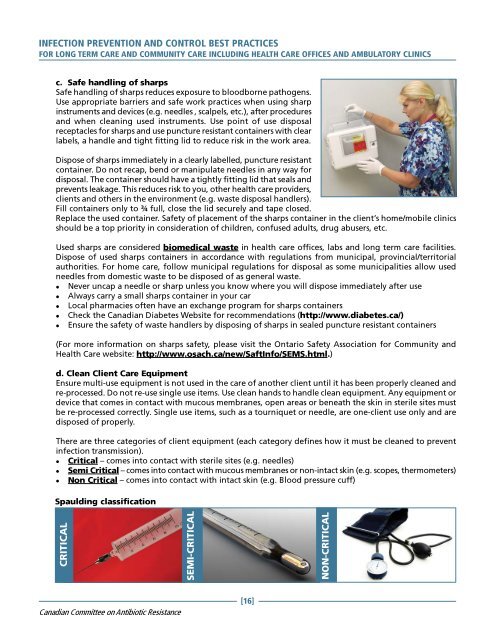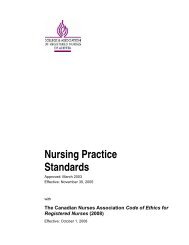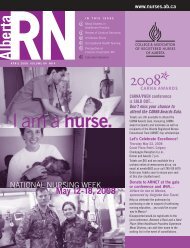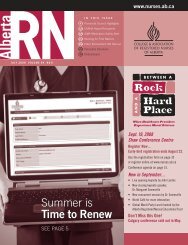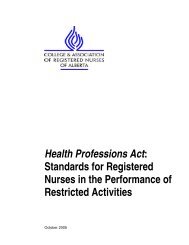Infection Prevention and Control Best Practices - College ...
Infection Prevention and Control Best Practices - College ...
Infection Prevention and Control Best Practices - College ...
You also want an ePaper? Increase the reach of your titles
YUMPU automatically turns print PDFs into web optimized ePapers that Google loves.
INFECTION PREVENTION AND CONTROL BEST PRACTICES<br />
FOR LONG TERM CARE AND COMMUNITY CARE INCLUDING HEALTH CARE OFFICES AND AMBULATORY CLINICS<br />
c. Safe h<strong>and</strong>ling of sharps<br />
Safe h<strong>and</strong>ling of sharps reduces exposure to bloodborne pathogens.<br />
Use appropriate barriers <strong>and</strong> safe work practices when using sharp<br />
instruments <strong>and</strong> devices (e.g. needles , scalpels, etc.), after procedures<br />
<strong>and</strong> when cleaning used instruments. Use point of use disposal<br />
receptacles for sharps <strong>and</strong> use puncture resistant containers with clear<br />
labels, a h<strong>and</strong>le <strong>and</strong> tight fitting lid to reduce risk in the work area.<br />
Dispose of sharps immediately in a clearly labelled, puncture resistant<br />
container. Do not recap, bend or manipulate needles in any way for<br />
disposal. The container should have a tightly fitting lid that seals <strong>and</strong><br />
prevents leakage. This reduces risk to you, other health care providers,<br />
clients <strong>and</strong> others in the environment (e.g. waste disposal h<strong>and</strong>lers).<br />
Fill containers only to ¾ full, close the lid securely <strong>and</strong> tape closed.<br />
Replace the used container. Safety of placement of the sharps container in the client’s home/mobile clinics<br />
should be a top priority in consideration of children, confused adults, drug abusers, etc.<br />
Used sharps are considered biomedical waste in health care offices, labs <strong>and</strong> long term care facilities.<br />
Dispose of used sharps containers in accordance with regulations from municipal, provincial/territorial<br />
authorities. For home care, follow municipal regulations for disposal as some municipalities allow used<br />
needles from domestic waste to be disposed of as general waste.<br />
� Never uncap a needle or sharp unless you know where you will dispose immediately after use<br />
� Always carry a small sharps container in your car<br />
� Local pharmacies often have an exchange program for sharps containers<br />
� Check the Canadian Diabetes Website for recommendations (http://www.diabetes.ca/)<br />
� Ensure the safety of waste h<strong>and</strong>lers by disposing of sharps in sealed puncture resistant containers<br />
(For more information on sharps safety, please visit the Ontario Safety Association for Community <strong>and</strong><br />
Health Care website: http://www.osach.ca/new/SaftInfo/SEMS.html.)<br />
d. Clean Client Care Equipment<br />
Ensure multi-use equipment is not used in the care of another client until it has been properly cleaned <strong>and</strong><br />
re-processed. Do not re-use single use items. Use clean h<strong>and</strong>s to h<strong>and</strong>le clean equipment. Any equipment or<br />
device that comes in contact with mucous membranes, open areas or beneath the skin in sterile sites must<br />
be re-processed correctly. Single use items, such as a tourniquet or needle, are one-client use only <strong>and</strong> are<br />
disposed of properly.<br />
There are three categories of client equipment (each category defines how it must be cleaned to prevent<br />
infection transmission).<br />
� Critical – comes into contact with sterile sites (e.g. needles)<br />
� Semi Critical – comes into contact with mucous membranes or non-intact skin (e.g. scopes, thermometers)<br />
� Non Critical – comes into contact with intact skin (e.g. Blood pressure cuff)<br />
Spaulding classification<br />
CRITICAL<br />
Canadian Committee on Antibiotic Resistance<br />
SEMI-CRITICAL<br />
[16]<br />
NON-CRITICAL


